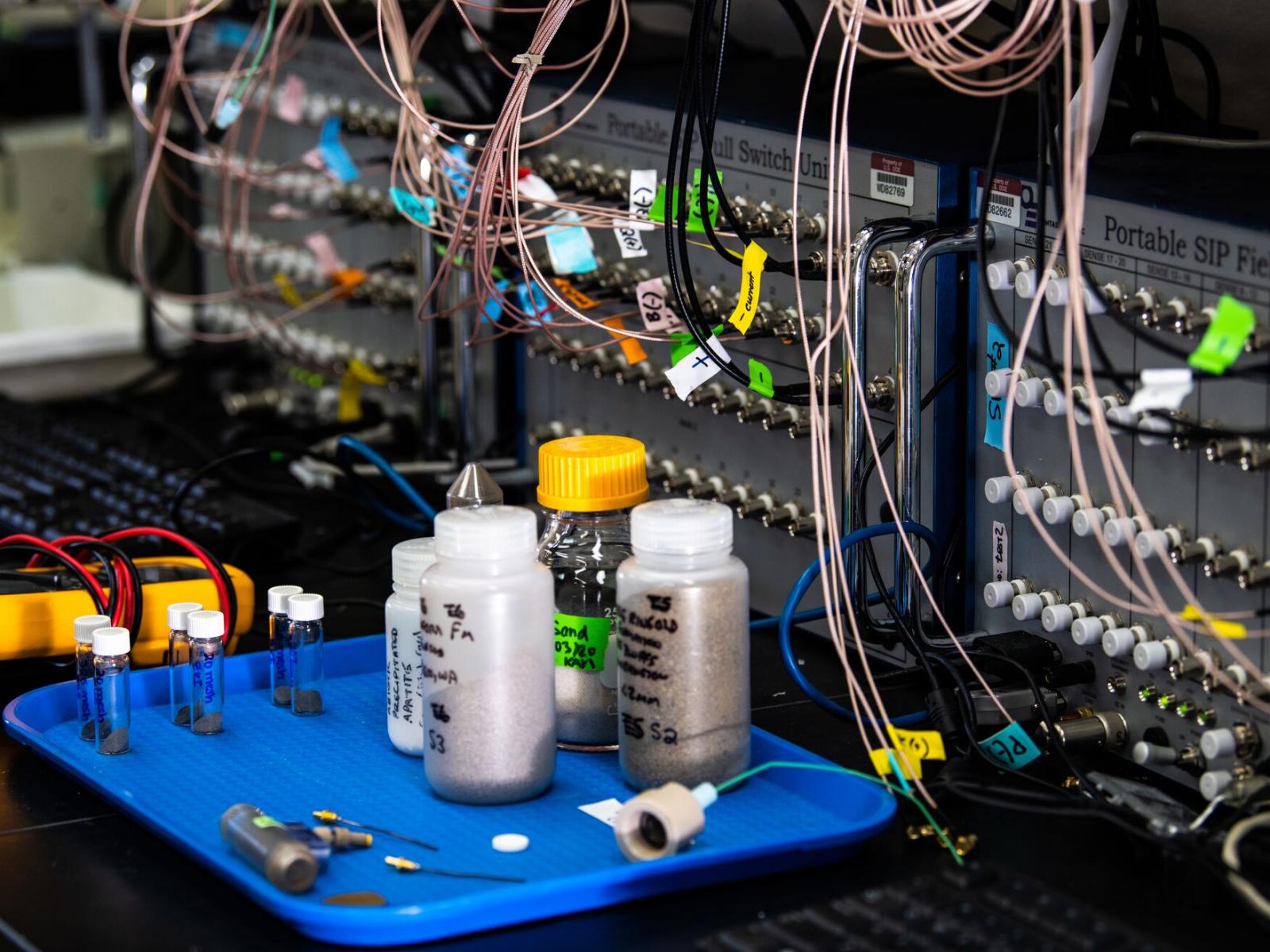Applied Subsurface Science and Characterization Laboratory
Investigating what lies beneath

In the Applied Subsurface Science and Characterization Laboratory at PNNL, state-of-the-art instrumentation and analytical techniques enable researchers to characterize the critical properties of sediment and rock that control the subsurface movement and reactions of chemicals, water, and gases. Here, different components of SIP column experiments are laid out on the tray with the electrical connection boxes in the background, major components include remedial amendments (small vials), sediments (bottles), column components, and electrodes (silver-silver chloride wires).
(Photo by Andrea Starr | Pacific Northwest National Laboratory)
Have you ever wondered what is beneath the ground you walk on?
The Earth’s subsurface environments serve essential roles in human civilization. This vital portion of the planet provides 98% of the water that is directly useable by humans (most of our fresh water source) and a remarkable 80% of the world’s current energy resources. It holds an enormous sustainable renewable energy resource, geothermal energy, that has yet to be significantly tapped. The subsurface plays a critical role in the Earth’s carbon and nanomaterial cycles, and therefore in climate change; it is a critical component of the U.S. strategy for addressing climate change through geologic carbon sequestration.
So what is limiting us from effectively accessing these vital resources or our ability to effectively implement a transformational technology to help with climate change or remediation of a complex contaminated site?
The fundamental challenge of understanding and predicting subsurface processes in response to natural and engineered inputs originates in the vast spatiotemporal changes and heterogeneities from microscopic to macroscopic scales in physical, chemical, and biological properties and processes. The challenges posed by heterogeneity and time variance are magnified by the overall difficulty and expense of accessing the subsurface.
In other words, visualizing the subsurface is both extremely expensive and dramatically limited relative to observations above the surface. Combined, heterogeneity and inaccessibility significantly constrain the collection of spatiotemporal subsurface information using current technologies and approaches. This reflects an inadequacy of the data needed to interrogate behavior and understand what controls that behavior.
How is PNNL stepping up to this challenge?
PNNL's mission is to provide the scientific and systems engineering expertise, facilities, and assets to autonomously interrogate, understand, predict, and control, with more detail and accuracy, natural and engineered processes in subsurface environments. PNNL is a recognized leader in high-precision remote and autonomous sensing for interrogating, understanding, predicting, and controlling complex subsurface environmental systems to better enable energy prosperity (e.g., fossil, geothermal, and nuclear energy), national security through counter-proliferation, environmental resilience, and scientific discovery.
One of the critical assets of this mission is the Applied Subsurface Science and Characterization Laboratory. PNNL researchers have access to state-of-the-art instrumentation and analytical techniques that allow characterization of critical properties of sediment and rock that control the movement and reactions of chemicals, water, and gases of interest to diverse sponsors working to remediate groundwater and soils, sequester contaminants or carbon, quantify the delivery of nutrients and carbon to surface water and the atmosphere, and advance fundamental subsurface science.
PNNL’s expertise grew out of decades of providing scientifically-based solutions for complex environmental remediation at the Hanford Site in Washington state. Our applied subsurface science and engineering capabilities cross-cut missions in fundamental science, sustainable energy, and national security with the Department of Energy offices of Science, Nuclear Energy, Environmental Management, Fossil Energy and Carbon Management, and Geothermal Technology, plus the Department of Defense, the Department of Homeland Security, the Nuclear Regulatory Commission, the National Nuclear Security Administration, the Environmental Protection Agency, and other sponsors.